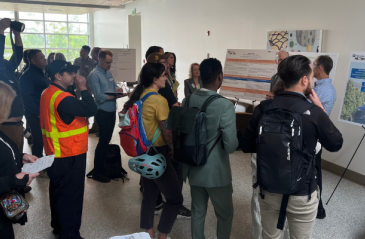
The information barriers holding back climate action and how to break them

The hype cycle shows how a technology develops from conception to adoption
Share articleHow do new technologies arrive at the plateau of productivity? @dannybuerkli explains...
Share articleAsking about impact, rather than appearance, can help technologies progress faster
Share articleWe put our vision for government into practice through learning partner projects that align with our values and help reimagine government so that it works for everyone.
The hype cycle has quickly taken firm root in both the public and private sectors. Created by IT consultancy Gartner, it is a graphic that represents how a technology develops from conception to maturity to adoption. As new technologies and ways of doing things come into the world it takes experimentation to fully grasp the potential (or lack thereof) of something new. And much like in the private sector, the hype cycle can be applied just as well within government.
New technologies start in the technology trigger phase, climb the peak of inflated expectations, fall into the trough of disillusionment, and traverse the slope of enlightenment before finally arriving at the plateau of productivity. Things go from new and shiny to mature, from hyperbolic to realistic expectations, from courageous first users to mainstream adoption.
New Public Management (NPM) was at one point the peak of inflated expectations, but is now firmly and, many would argue, productively embedded in the practices of many governments. Along the way governments have learned, sometimes painfully, how to make best use of NPM. With that in mind, and without being too serious about it, here are 10 hot topics in government innovation and their place in the hype cycle:
Transitioning out of technology trigger phase, scaling peak of inflated expectations
If you're a policymaker you should be very afraid. DeepMind has beaten the world's best Go player, something all experts thought was at least another decade out, and governments are only beginning to grasp what might be possible using machine-learning and artificial intelligence (AI). When will you be replaced? Expectations are high, but will rise even more as governments start experimenting in earnest with this technology.
Peak of inflated expectations
Blockchain is the technology behind bitcoin. While worthwhile government applications for blockchain will surely emerge, it no doubt has been hyped. Few people seem to genuinely understand what the blockchain can and cannot do. Everyone is still trying to figure out where this really makes sense.
Peak of inflated expectations
Originating in the world of product and service design, this method borrows heavily from ethnography and is particularly valuable to improving governmental services. Design is not likely to be the solution for all of our governmental problems, but you wouldn't be able to tell if you only listened to some speakers at design conferences. It's a solid method that delivers great results if used thoughtfully and, in the right context, we should stick with it through the disillusionment that's coming.
Just past the peak of inflated expectations, about to descend into trough of disillusionment
Policy Labs are the hottest property in government innovation land. They bring together design thinkers and other creative problem-solvers to tackle government's hardest problems. Organisations such as MindLab, OPM Lab and the UK Policy Lab are leading the way. The trough of disillusionment will likely come as more governments adopt the model, but it's worth sticking with it since they, if set up and run well, can make a difference.
Trough of disillusionment
Having originated in development economics many countries developing and developed alike are warming up to the idea that randomised studies of interventions can help them figure out what works and what doesn't. After an initial hype practitioners and policymakers are getting better at understanding where and how this method can deliver most value.
Trough of disillusionment
Social Impact Bonds, SIBs for those in the know, were first trialled in Peterborough, UK, in an attempt to reduce prisoner recidivism by using an innovative financing mechanism where private investors would get a return if the new intervention performed better than a conventional one. After much initial, and justified, excitement it today seems clear that they should work in theory, but it's less clear where they work in practice.
Trough of disillusionment
To the casual observer it may not be immediately obvious if "open data" has produced much of practical value to citizens, other than better public transportation apps and free pizza at government-sponsored "hackathons". Making government data openly accessible should improve accountability and allow smart outside actors to spot opportunities for improvement, but so far actual results have been below expectations.
Slope of enlightenment
Behavioural science has given governments a new tool to not just better understand the sometimes puzzling decisions their citizen's make but to find ways to gently nudge people towards better choices. The method is well on its way to mainstream adoption in some (Anglo Saxon) countries, but remains under-utilised in others.
Slope of enlightenment
Allowing citizens to conduct their interactions with government online is a somewhat boring but absolutely essential service to citizens. No one should be subjected to long, pointless queuing to pick up a piece of paper anymore. Building user-friendly government online services can also act as a gateway to a more digitally enabled government in other areas.
Plateau of productivity
As a structured way to cut waste in all kinds of processes "lean" has long established itself as a useful tool for government operations too, not just for car factories. While "lean" doesn't generate any particular excitement anymore it's become a productive tool to improve government services.
***
The movement of new ideas, methods and technologies through the hype cycle is inevitable, as we collectively take promising new approaches and figure out what exactly they can and cannot do. Asking about impact, rather than appearance, can help us get there faster and discern the useful from the hopeless a bit quicker. Some amount of experimentation where the end result is unknown is however inevitable and indeed desirable.
Not all countries, regions or cities are in the same place concurrently. Inflated expectations in one place can co-exist with utter disillusionment in others. All of these methods have a valuable contribution to make, and it is worth persevering through the trough of disillusionment if we want governments and citizens to reap the benefits.












